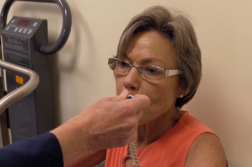ORLANDO, Fla. (Ivanhoe Newswire) It’s that time again. Our clocks will spring forward on Sunday, March 13th, 2022. But what can losing an hour do to your health? Ivanhoe reports on the health consequences of daylight saving time and some ways people can make that transition a little easier.
Skipping an hour ahead this spring for daylight saving time, doesn’t just change the time.
“There’s also a change in your sleep and your circadian rhythm and ultimately that has an effect on your physical health as well as mental health,” detailed Caitlin Nicholson, MD, a sports medicine physician at Midwest Orthopaedics at Rush.
In fact, a University of Michigan study found hospitals report a 24 percent spike in heart attack visits the Monday following the loss of an hour for daylight saving time. Stroke rates were also eight percent higher the first two days after the time change. So how can you make that springing forward transition easier on your health?
“You can actually start shifting the times you go to bed and the times you wake up by about 15 to 20 minutes per night,” Dr. Nicholson told Ivanhoe.
Also expose yourself to sunlight in the morning because that helps your circadian rhythm more closely align to that change in sleep. And exercising at the right time can get your body ready for the transition. It’s best to workout in the morning or early afternoon.
“I would avoid exercising right before bed as that can wake you up a little bit during the time that you’re going to want to be sleeping,” said Dr. Nicholson.
The American Psychological Association said people lose on average 40 minutes of sleep the Monday after spring forward. Hawaii, Puerto Rico, the U.S. Virgin Islands and parts of Arizona do not have daylight saving time.
Contributors to this news report include: Milvionne Chery, Producer; Roque Correa.
Sources:
https://www.timeanddate.com/time/change/usa
https://openheart.bmj.com/content/1/1/e000019, https://utswmed.org/medblog/daylight-saving-time-sleep-health/#:~:text=Cardiovascular%20risks,days%20following%20both%20time%20changes
SPRING FORWARD TO BETTER HEALTH
REPORT #2942
BACKGROUND: Daylight saving time, or DST, is the practice of setting the clocks forward one hour from standard time during the summer months, and back again in the fall, in order to make better use of natural daylight. Less than 40% of the countries in the world use DST. Some countries use it to make better use of the natural daylight in the evenings. The difference in light is most noticeable in the areas at a certain distance from Earth’s equator. DST is also used to reduce the amount of energy needed for artificial lighting during the evening hours. However, many studies disagree about DST’s energy savings, and while some studies show a positive outcome, others do not.
(Source: https://www.timeanddate.com/time/dst/)
THE STUDY: A 2019 report found a higher risk of heart attack after both time changes, but particularly during daylight saving. Interruptions to circadian rhythm can also impair focus and judgment. A 2020 study found fatal traffic accidents increased by 6% in the United States during daylight saving time. Though “falling back” gives you a chance to catch up on lost sleep, it can also be a difficult adjustment, says Ramiz Fargo, MD, medical director for the Sleep Disorders Center and a sleep medicine doctor at Loma Linda University Health. It may also be hard for people with mood disorders, he says. One study showed that hospitals reported an 11% increase in depressive symptoms just after the fall time change. This may be a result of lost daylight, he says.
NEW REGULATIONS: Experts are calling for an end to the back-and-forth that confuses our bodies twice per year and instead, establish permanent Standard Time. Anita Shelgikar, M.D., MHPE, co-authored a recent position statement from the American Academy of Sleep Medicine calling for an end to Daylight Saving Time. “There is growing support for the idea of not switching clocks twice per year,” she says. “There are proponents for establishment of either permanent Standard Time or permanent Daylight Savings Time. Eliminating Daylight Saving Time nationwide would require an act of Congress; however, state-level legislation is possible.”
(Source: https://healthblog.uofmhealth.org/wellness-prevention/why-we-should-abolish-daylight-saving-time)
* For More Information, Contact:
Ann Pitcher
Free weekly e-mail on Medical Breakthroughs from Ivanhoe. To sign up: http://www.ivanhoe.com/ftk



